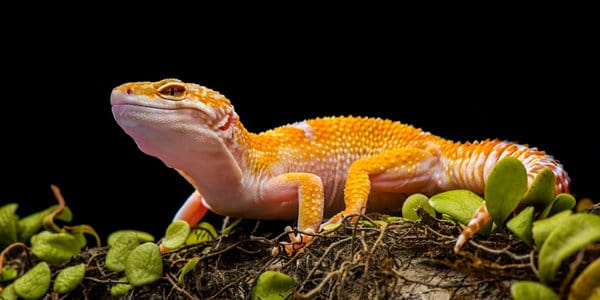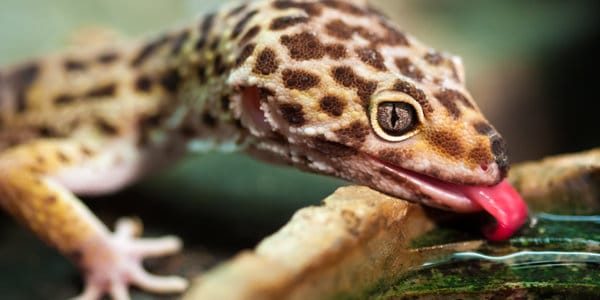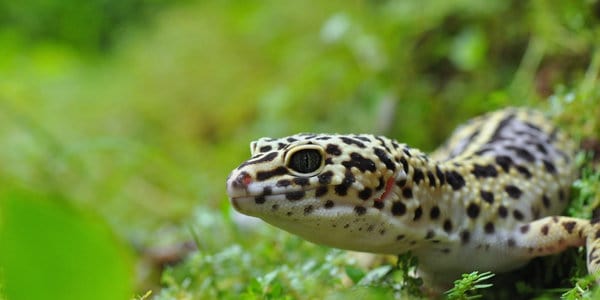1. Reduce Ventilation
Typically, pre-made leopard gecko terrariums come with multiple openings for adequate air circulation. Most enclosures bought from the stores come with a meshed top.
When the tank’s humidity levels drop too low, you can cover the meshed part to increase moisture levels in the cage.
You can use transparent glass or foil to cover the opening at the top to maintain optimal humidity inside the leopard gecko cage.
However, don’t cover the entire mesh, as your reptile pet still needs to breathe fresh air.
The rule of thumb is to cover at least one-third or one-half of the meshed top and observe whether it will significantly alter the humidity levels.
2. Place a Water Bowl in the Warm End of the Cage
Your leopard gecko’s tank should have a water dish to ensure the animal has full access to clean water.
Besides providing your gecko with a place to quench its thirst, a water bowl helps increase the humidity inside the cage by allowing water to vaporize and escape into the air.
If you already have a water bowl inside the cage and the problem still exists, you should consider investing in a bigger water dish.
A larger water holding bowl will provide an extended surface area for the evaporation of more water into the atmosphere.
Placing the water dish on the warmer side can also help increase the humidity. The heat in the warmer side will evaporate more water, thereby leading to high humidity levels.
3. Install a Humid Hide
Placing hides inside an enclosure is a great way to create a near-natural habitat for your leopard gecko. A hide allows your gecko to feel secure and get some privacy.
If there’s low humidity in the cage, you can leverage a humid hide to restore the moisture to optimal levels.
A humid hide is lined up with a premium quality moisture-holding substrate, allowing the reptiles to check in when they feel dehydrated.
A humid hide will provide a great respite where leopard geckos can escape during shedding.
It can also help rebalance moisture levels in the rest of the enclosure, eliminating the risk of humidity levels dropping below the recommended range.

4. Change the Substrate
Are you still struggling to get your humidity levels right? Changing the substrate might salvage the situation.
Although substrates, such as reptile carpets, paper towels, and ceramic tiles, are considered the best, they are not great at retaining moisture.
Switching to good quality moisture retaining substrates like compressed coconut fiber, soil, or other organic fiber substrates, can boost the humidity in the terrarium and ensure that your reptile friend is happy and healthy.
However, ensure that the substrate you use doesn’t have loose particles that can increase the risk of impaction.
5. Add Live Plants
Another brilliant way to maintain and increase humidity is to put live plants inside the leopard gecko’s cage. Usually, plants absorb water through the roots and gradually release it into the atmosphere through the leaves.
You can add one or two live plants, but ensure they don’t take up too much space in the cage. Live plants will help restore the humidity, bring a natural allure, and act as enhancements to allow leopard geckos to climb.
However, it’s crucial to note that the amount of moisture released by live plants is too little, and it is better if they are used along with other items in this list, such as a water dish and quality substrates. They won’t make so much difference when used alone.
6. Install Foggers and Humidifiers
Humidifiers and foggers are some fantastic pieces of equipment that can help you restore the ideal humidity levels in your leopard gecko’s terrarium. These devices deliver fine water particles into the air, improving the humidity.
The best part is that foggers and humidifiers don’t condense water on surfaces or saturate decoration and accessories with water droplets.
They perform a sole function which is to increase humidity. When facing a low humidity problem, you can run a fogger or a humidifier for a few minutes at dawn or dusk to maintain optimal moisture levels.

Should You Mist a leopard gecko Tank to Increase Humidity?
Yes, misting a leopard gecko’s habitat is another excellent way to increase moisture and humidity levels. You can fulfill your pet’s moisture requirements with infrequent misting.
And since misting devices are available in automatic and manual systems, your choice will depend on your budget and convenience. Automated misting is more convenient as it allows you to routinely mist your cage without forgetting.
Misting will help maintain the right environment within your pet’s habitat. When the humidity levels are perfect, your leopard gecko will shed its skin without problems. Misting also allows substrates to absorb water to help maintain optimal humidity levels.
How Often and When Should You Mist Your Leopard Gecko Habitat?
The misting frequency will depend on whether your gecko is about to shed. You can mist your pet’s cage at least twice a week if your reptile friend is about to shed. Baby and juvenile leopard geckos’ cages can be misted daily since they are at a stage where they experience rapid growth and regular shedding.
Misting should be done in the morning and (or) in the evening to allow the animal to adjust to the conditions before the cage becomes too hot. However, you can choose to mist the cage any other time if you think it will help restore the optimal humidity levels.
And since humidity is a fickle mistress that changes based on the weather, you should not rush to mist your cage just because humidity levels have gone down drastically in a few hours. You should wait to mist your enclosure early in the morning or evening when temperatures are low.
Important Points to Remember When Misting a Leopard Gecko’s Tank
- Mist the habitat regularly if the leopard gecko is in the rapid growth stage or there’s no water source inside the cage. This will maintain humidity levels at an optimal level.
- When misting a leopard gecko’s habitat, ensure that humidity levels are maintained between 30% and 40%. Too much misting can lead to high humidity levels.
- The tank should be misted twice a week for adult geckos that are not shedding. It should be misted regularly if leopard geckos are shedding. These reptiles require a humidity of 70% to 80% when shedding their skin.
- Misting shouldn’t be confused with watering. Misting is primarily done to increase the humidity levels in the cage, while watering is done to hydrate leopard geckos.
Ideal Humidity for Leopard Geckos
Leopard geckos come from the rocky desert regions in south Asia, where there’s low rainfall and terrains don’t retain much water. For these reasons, these reptile pets are used to living in areas with low humidity levels.
The ideal humidity for leopard geckos is between 30% and 40%. This makes it challenging for these reptiles to survive in climates with humidity above or below this range. Pet owners must ensure that their leopard geckos’ tanks have the recommended humidity levels.
How Do You Monitor the Humidity in The Leopard Gecko Tanks
One of the essential accessories that you need to monitor and control humidity in a gecko’s terrarium is a hygrometer. This instrument will help you measure the amount of moisture in the air, allowing you to know when humidity surges or plummets.
Remember, three integral factors affect humidity:
- The amount of water that can be vaporized
- Temperature
- Moisture retention capability of the surrounding materials
Therefore, before you start worrying about humidity when setting up an enclosure, you must ensure that the temperature is stable, there’s an ample-sized water dish, and you have used the right substrate.
Trying to regulate the humidity and then changing heat sources, water sources, and substrate later is often inefficient.
However, since humidity is affected by the weather, you don’t have to worry any time it drops or increases. You should only worry when it drops below the recommended level and stays that way for a day or two.
Luckily, you can restore the humidity inside the leopard gecko cage to optimal levels in various ways.
Before we check out ways to increase humidity in a leopard gecko’s tank, let’s look at what happens to the leopard gecko if the humidity levels are too low.

Dangers of Low Humidity Levels in a Leopard Gecko’s Tank
Dehydration and dry skin
When there’s low humidity in the cage, leopard geckos are likely to suffer from dehydration that will manifest through dry skin.
Low humidity will make these reptile friends get thirsty faster and suffer dehydration if there’s no clean water available in the cage.
For this reason, you must provide your leopard gecko with fresh and clean water daily.
Increased Risk of Infection
Leopard geckos can stay in less humid environments for a few hours but not for an extended period. If the humidity in their habitat drops below 30%, these creatures will have an increased risk of infection.
For instance, low moisture levels can lead to cracking of the skin, providing a pathway for the entry of pathogens.
Stress
In their natural habitat, leopard geckos are used to humidity levels of between 30% and 40%. Although they’ll survive if the humidity drops to 20% for a few hours, they’ll only live a healthy and happy life when the moisture levels are above 30%
If the cage becomes less humid for an extended period, it can cause discomfort and lead to various health complications, which might be stressful for your pet.
Problematic Shedding (Dysecdysis)
Like all other reptiles, leopard geckos must shed their skin regularly to allow consistent growth. These reptiles shed their outer skin more often during the rapid growth stage.
One of the requirements for successful shedding is high humidity. When leopard geckos are shedding, they need humidity levels of between 70% to 80%. If the enclosure has low humidity levels, your leopard gecko will suffer dry skin and experience problematic shedding, or what is known as dysecdysis.
Retained skin particles can also cause vision problems when in the eye region or affect blood flow to appendages.
This means that problematic shedding can cause fingers, nails, and tails to die and fall off due to blood flow restrictions. Therefore, you should do everything to ensure that the humidity stays above 30%.
FAQs About Increasing Humidity Levels in a Leopard Gecko Tank
What Humidity is Considered Too Low for Leopard Geckos?
Leopard geckos live comfortably in environments offering 30% to 40% humidity levels. This means that the lowest humidity they can be comfortable in is 30%. However, these animals can cope with humidity above 20%, even though it will make them uncomfortable.
My Leopard Gecko is Always on the Humid Side. Should I Be Worried?
When your gecko spends a few days in the humid hide, it’s likely preparing to shed. However, if the behavior continues for weeks, they might go there for other reasons.
First, the cage might have low humidity, forcing leopard geckos to hide in a more conducive zone. If the habitat doesn’t have dry hides, the leopard gecko might be hiding in the humid hide to stay safe.